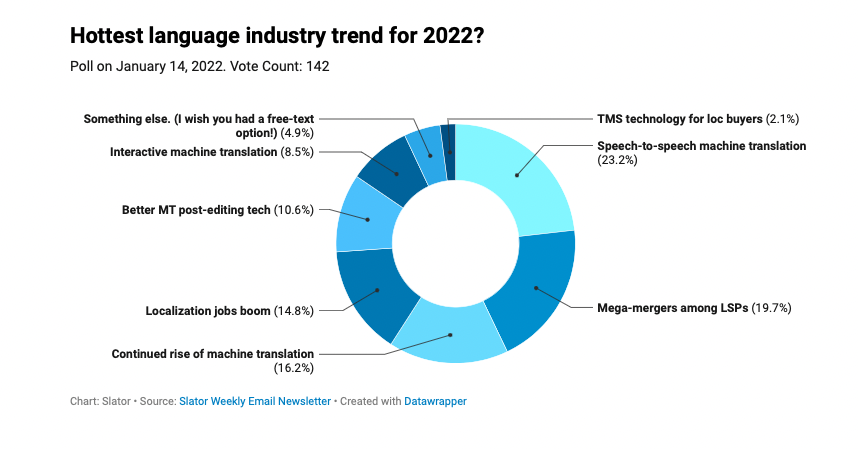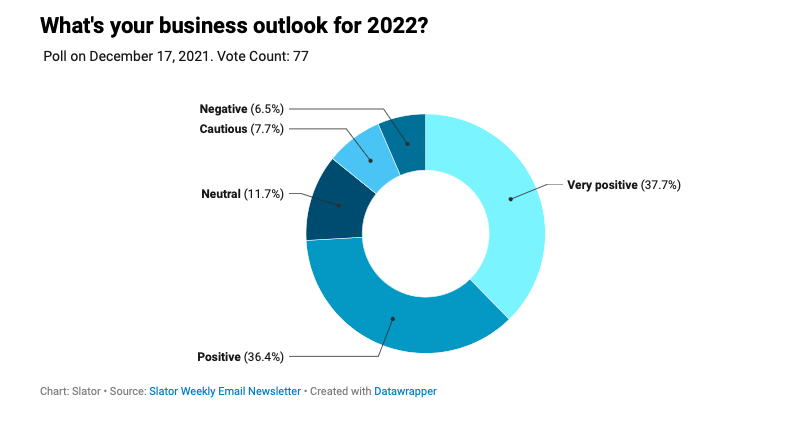The Biggest Translation Trends of 2022: Medical Translation, DeepL, and More
Each year, we ask ourselves the same thing: what are some developments in the language industry that we should keep an eye out for? The kinds of issues and events that arise tell us much about the state and direction of the industry, and thhis year is no different; Slator has recently released their annual Language Industry M&A and Funding Report, as well as the results of a poll survey on what people deem to be the hottest language industry trend for 2022. Here’s what the internet thinks about the future of translation:

Image Credits: Marion Marking, “Reader Polls: Hottest Localization Trend of 2022 Divides Opinions”
Speech-to-speech machine translation leads the way with 23.2%, followed by mega-mergers among LSPs. This particular trend is reminiscent of 2020, which saw important mega-mergers such as RWS-SDL and Acolad-Amplexor. A smaller 16.2% answered with “continued rise of machine translation,” which outpolled “localization jobs boom” and “better MT post-editing tech.” As for the question of how business is looking like, here’s what the internet responded with:

Image Credits: Marion Marking, “Reader Polls: Hottest Localization Trend of 2022 Divides Opinions”
Things are looking good for most people, and it’s no coincidence; while the language industry did suffer slightly from the COVID pandemic (the industry was assessed at around $46.9 billion in 2019, which dipped in 2020), the market size grew again to $56.18 billion. Interprenet, a world-renown interpretation service, notes that the travel and tourism industry suffered heavily during the pandemic; on the flip side, other industries such as social networks, gaming, and healthcare experienced meaningful growth in these increasingly virtual COVID-19 times. With many workers and services moving to online and remote work, more budget is now allocated to localization and translation—in other words, the language industry.
Interprenet also reveals that there are currently 640,000 linguists working worldwide, with 56,000 of them located in the United States; the US Bureau of Labor and Statistics predicts that the US employment of linguists is expected to increased by nearly 24% in the next 8 years, with “about 10,400 openings for interpreters and translators” projected each year. Considering how the streaming industry—perhaps one of the biggest beneficiaries of COVID-19—is expected to reach over $70 billion USD this year, the demand for localization specialists and translators has yet to reach its full potential in the coming years.
The Maverick Group—an advertising and design company based in the UK—puts it in much simpler terms. According to their data, the number of people working in the translation industry has doubled between 2013 and 2020; the numbers are expected to grow by 20 percent from 2019 to 2029, which is “much faster than the average for all occupations.” There are seven particular reasons, according to the Maverick Group, as to why growth seems imminent and inevitable:
- Tech and Globalization
- As of now, 53% of internet content is written in the English language
- However, only 20 percent of the world population actually speaks English
- Videos and Podcasts
- Average video consumption is 84 minutes per day in 2019
- Cisco predicts that 82% of global internet traffic will come from video streaming and downloads by the end of this year
- With this rising need for video consumption, the demand for localization, subtitling, and dubbing ensues
- E-Learning
- Forbes estimates that the e-learning field will be worth around #355 billion by the year 2025, driven by COVID-19-induced remote learning
- Remote Working
- Demand for translation and interpretation is on the rise, due to COVID-19
- Medical Translation
- Given the pandemic’s global reach, the field of medical translation has become more necessary and important than ever
- A Growing Workforce
- The loss of job opportunities due to COVID-19 has forced many unemployed people into the realm of translation as a way of utilizing their language skills as a source of income
- Artificial Intelligence
- Recent developments in artificial intelligence has created much demand for language specialists capable of facilitating the integration of AI technology to linguistic work
It’s important to note that many of the Maverick Group’s predictions are based on general trends in the industry, which is to say, not specific, concrete data. That does not discredit their ideas; rather, these seven points reveal a slow yet unstoppable rise in the demand for translation and interpretation—more efficient, nuanced, and human ways of communication.
Nuanced, accurate translation is especially necessary in the field of medical translation, which has been significantly impacted by COVID-19. In a New Yorker article by Clifford Marks, the vital yet demanding work that medical interpreters undertake is narrated in detail through the eyes of a Spanish-English translator named Lourdes Cerna, whose job as a medical interpreter has proven vital to hospitals around the US but at the cost of her own time and mental health. Marks describes her as “part of a burgeoning profession that has assumed a critical role during the pandemic.” Marks also notes that “researchers have found that, when patients do not have access to an interpreter, they are more likely to stay in the hospital longer and to be readmitted later on.”
Medical interpretation is just one of many fields of the language industry that has finally seen the light of day after decades of being underestimated and underfunded. Another field that has risen to the forefront in the past years is machine translation, which has greatly facilitated communication and paperwork in various industries. A recent bout regarding the use of machine translation in the workplace helps us understand how essential MT has become in the professional realm:
Swiss Post, Switzerland’s national postal service — and one of the country’s largest employers — caused an uproar when it banned employees from using free online translation programs, namely Google Translate and DeepL, for their work.
Slator’s Seyma Albarino explains that the Swiss Post mandated this out of security reasons, and in lieu of these high-tech translation engines, workers were redirected to “Post Translate,” Swiss Post’s very own machine translation service.
But the reaction was largely critical, the reason being Post Translate is not as robust of a machine as DeepL or Google Translate, leading to difficulties in processing and translating documents. The reaction reveals a crucial fact in the modern workplace: translation engines are now essential for daily business, especially for companies like Swiss Post that deal with international commerce.
These events go to show that machine translation is an indispensable cog of the modern workplace. In particular, DeepL has taken its place as one of the most widely used machine translations in business—and it consistently outranks other translation engines in its performance. With innovative network architecture, vast training data, impeccable training methodology, and sheer network size, DeepL lies at the heart of international business, used not only by monolingual workers to translate documents but also by translators and localization specialists to aid in their human translations.
Charting the path of DeepL’s recent rise to success helps us better understand how deeply the language industry has exerted its influence in the realm of business. According to Slator’s research, DeepL is, after its 2017 release, now “deeply integrated into the business processes of companies across countries and sectors, with clients including Roche, Fujitsu, Axa, Best Buy, Nokia, Rakuten, Siemens, and Elsevier. Deutsche Bahn (DB), the world’s second largest transport company, started using DeepL three years ago… it quickly became popular and is now heavily used across the company daily.” In a 2021 review of its accomplishments, DeepL revealed that “by adding 13 new language to DeepL Translator… we reached 105 million more native speakers worldwide.” Add to that DeepL’s 1 billion user population: an impressive feat that’s changing the face of international business.
Rivaling DeepL is Google, who “currently has more than 91 research scientists specializing in Machine Translation, along with more than 400 NLP specialists and over a thousand experts in Machine Intelligence.” Compare that with Facebook’s own artificial intelligence-powered machine, which generates 20 billion translations per day on its social network, as reported by Worldcrunch. Spurred by competition and demand, these companies are innovating at a speed unrivaled by any previous advancements in linguistics, and 2022 is no different. Combining the world of language with artificial intelligence, machine translation is surely the next big thing to revolutionize global commerce and daily life.
We must look at the big picture; the rising need for medical translation and machine translation is the natural byproduct of a larger growth in artificial intelligence technology, catalyzed by the COVID-19 pandemic that has effectively normalized remote work and global communication. Much of what we see as trends are predicated on real-life events such as the pandemic; it’s hard to say what’s to come next in this unpredictable little world of ours. Will a prolonged pandemic state give rise to further developments? Will the world’s attention shift to other sectors—perhaps aeronautical engineering, or maybe global politics—and effectively abandon machine translation development? We can take a stab at reading the future and say that, no, machine translation is a trend that’s here to stay. We have had a taste of the wonders of unaided, unsupervised translation; its possibilities are not only boundless, but crucial for humanity.
All this isn’t to say that machine translation is perfect; in fact, machine translation is nowhere near it. For proper translation to take place, there must be additional human oversight to reassess machine outputs; translation machines are not yet capable of understanding context and repetition, as well as noticing deliberate word choices and usage. That is why translation services—aided by machine translation, yes, but powered by human translation—are so critical. Human translators are still—and will be—the only ones able to provide satisfactory translations in this increasingly global, increasingly efficient world.
We here at Sprok DTS are excited to see what 2022 brings to the language industry. We utilize the best technology and the best minds to bring our clients the best, most polished translations possible, and to do so, we are constantly on the lookout for technological insights that might possibly help our translators work better, faster, and more accurately.
References
https://slator.com/swiss-post-bans-deepl-backs-down-after-staff-uproar/
https://www.deepl.com/en/blog/how-does-deepl-work
https://www.deepl.com/en/blog/deepl-2021-year-in-review
https://www.morningbrew.com/emerging-tech/stories/2022/02/09/breaking-down-an-ai-for-translation-middleman
https://www.forbes.com/sites/samanthabaker1/2019/06/27/will-this-german-startup-win-the-translation-game/?sh=45f8c968db9d
https://slator.com/hottest-localization-trend-of-2022-divides-opinions/
https://www.interprenet.net/interpreting-services-articles/solutions/language-services-industry-trends/
https://www.statista.com/statistics/257656/size-of-the-global-language-services-market/
https://maverick-group.com/translation-trends/
https://www.newyorker.com/science/medical-dispatch/interpreting-during-a-pandemic
https://slator.com/inside-deepl-the-worlds-fastest-growing-most-secretive-machine-translation-company/